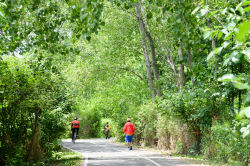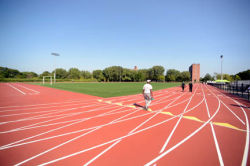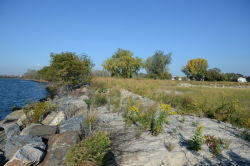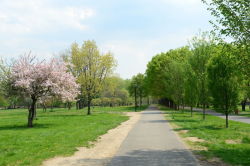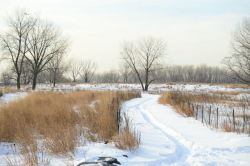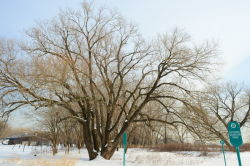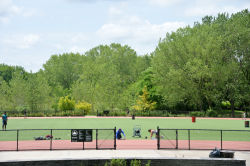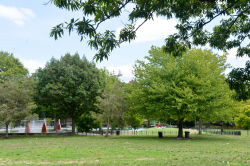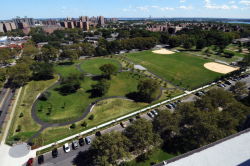Soundview Park
Soundview Park
In the 1830s the Ludlow family owned considerable property on Clason Point, including much of the site that would become Soundview Park. Ludlow's Black Rock Farm included Barrett's Creek, named for Samuel Barrett, an original settler of Clason Point. The farm was named for a large boulder found in a salt marsh near the junction of Ludlow's Creek and the Bronx River. The black rock is formed of gneissBa coarse-grained, imperfectly layered metamorphic rock, characterized by alternating dark and light bands. It is from the Hartland formation and dates back hundreds of millions of years, when an unknown land mass collided with North America and buried sedimentary rocks and volcanics on the edge of the continent. Several miles below the earth's surface, at temperatures over 1000 degrees Fahrenheit, the sedimentary rock and volcanics were forged into gneiss.
The massive boulder may have been a glacial erratic transported to the South Bronx by a glacier about 10,000 years ago. Mistaken for a meteorite by early settlers, the boulder was moved to Soundview Park, where it can be seen today. When the City of New York acquired the original 93 acres of land for a new park in 1937, the entire area was composed of marshland. The creeks and terrain along the left bank of the Bronx River, made the parkland unusable. Local lore asserts that New York City Parks Commissioner Robert Moses named the site Lafayette Park.
Marquis de Lafayette (1757-1834) was a major general in the Continental army during the American Revolution. In 1789 he returned to France where he served as a commander of the militia in the French Revolution and was a liberal member within the National Assembly. Lafayette made various trips to New York City, from 1784 through 1825. Each time he was honored with banquets, parades performances, and an artillery salute. After some contention, Commissioner Moses yielded to local residents who wanted the park name to express a reference to the neighborhood. "Soundview" was inspired by historical maps of the East River, which was once known as Long Island Sound. On the northwest side of the park, Soundview Avenue was part of the colonial road leading to Clason Point.
In 1940 the City acquired by condemnation an additional 63 acres adjacent to the park. Subsequent additions in 1953 and 1967 expanded the park's area. In 1994 the sewer systems, and control vaults were renovated and dams were installed. The playground was improved in 1997, and the sidewalks and pavements were repaired in 1998. Called the "Gateway to the Bronx River," Soundview Park is situated where the Bronx River opens into the East River. The Bronx River changes from a saltwater river to the only freshwater river in New York City at Westfarms, just a few miles north of Soundview. With its extensive views of the water, Soundview Park celebrates the beauty of both the Bronx and East Rivers.
Check out your park's Vital Signs
Clean & Safe
Green & Resilient
Empowered & Engaged Users
Share your feedback or learn more about how this park is part of a
Vital Park System

